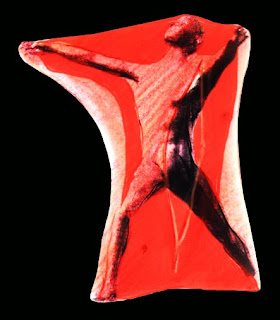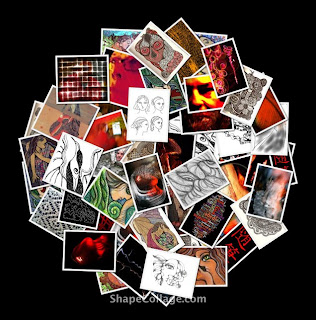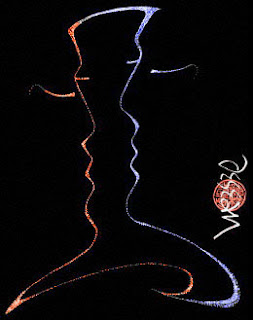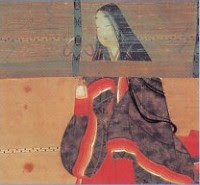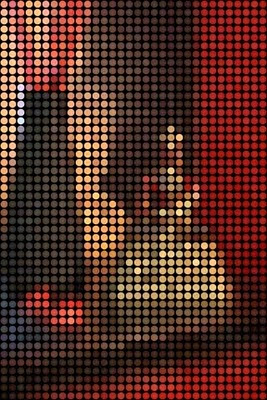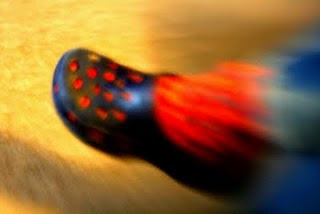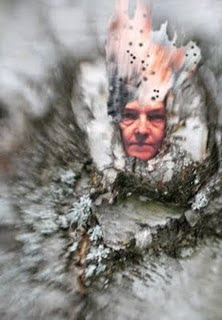I notice that I had tried to give the outer edges of the image a pixelated effect, trying to imagine a photo captured through frosted glass or framed through an alien spaceship's camera lens.
Cyanovoids
Twenty years ago, I began my first colour collages involving photos or digitized images, 3d objects and digital painting. Browsing through my portfolio, I noticed Cyanovoids, one of my first (rather low res, by today's standards) attempts at photo montage. Bleu, a friend, kindly posed for me (thus the title, 'cyan ovoids'). And guess what? Its theme also seems to evoke rising, becoming visible, appearing, rebirth, origin, source... I guess the quest for ortus has been with me for a while...
Fabric skins
Several years ago, in preparation for one of my 'skins' installations, I drew a concept sketch for a fabric skin, then had it fabricated by a seamstress. The womb-like skin membrane would allow someone to wear it and interact with it, going through various poses that evoked a struggle for birth, freedom and escape; the person could eventually exit the skin through a partial slit in the seam, shedding a now lifeless skin. This also evokes the notion of metamorphosis, not unlike the butterfly emerging from the chrysalis, or the chick from the egg.
A friend tried out the embryonic sac.
A friend tried out the embryonic sac.
I'll be using the skin again in a future photo shoot with James, exploring the Ortus theme.
Ortus
a latin word meaning rise, becoming visible, appear, birth, origin, source
I am playing with electronic collages using some of my photo elements, exploring the theme of 'Ortus'. This first collage evokes the notion of fire and ice, contrasting elements that we normally don't associate with beginnings or births, but rather with suspended life or death. In the distance, I've brought back from Moonbeam a silhouetted skyline that seems to be on fire. I also photographed a beautiful block of ice... reminiscent of a snow globe. The creature trapped inside is shrouded in fabric. The overall effect is one of containment, yet of imminent new life... birth from ice and fire, eros and logos.
I am playing with electronic collages using some of my photo elements, exploring the theme of 'Ortus'. This first collage evokes the notion of fire and ice, contrasting elements that we normally don't associate with beginnings or births, but rather with suspended life or death. In the distance, I've brought back from Moonbeam a silhouetted skyline that seems to be on fire. I also photographed a beautiful block of ice... reminiscent of a snow globe. The creature trapped inside is shrouded in fabric. The overall effect is one of containment, yet of imminent new life... birth from ice and fire, eros and logos.
Collaging
I found a great tool, Shape Collage, that magically converts a series of photos or images to an electronic collage in a variety of shapes. I suppose one could also display text pages in a similar fashion. The overall effect is quite nice graphically.
Recollections
Poems and images created ages ago, suspended in time and floating in some forgotten web space, once retrieved from those soundless confines, then dusted and polished, often rekindle strong memories or express today's musings.
Longer
you evaporated
you disintegrated me
i would have loved
to love you
longer
than your telephone number
stayed
in the mist
on the mirror
of my hotel room
i would have loved
to live longer
for you
than that telephone number
scribbled on paper
with the burnt end
of a match
i loved
to want you
i would have wanted
to love you
longer
Fluid flames
Mary pointed me to another great online tool, Flame. I quickly began painting and writing, noticing instantly the flame-like quality of the trailing strokes—transparent, iridescent shapes materializing on the dark canvas, like diaphanous veils. In a sense, completely the opposite of flames that consume and destroy matter, these drifting forms grow and consume but space. I remember when, as a child, I would play for hours in my lab/studio, dropping coloured water from an eyedropper into test-tube like containers filled with clear water, admiring the dancing coloured streaks as the liquid veils sank to the bottom, eventually dissolving.
Harmony night grid
Harmony is indeed a great sketch tool, offering spontaneity, fluidity. It's just plain fun. This 2-layer image is made up of an inverted grid sketched in Harmony which I then superimposed over a photo of myself in order to see how colour could be introduced by using the Luminosity filter in Photoshop. The program provides black and white renditions only, which is great, but sometimes, one may want a dash of colour which could be introduced either through painting on a separate layer above, or by painting directly on a new layer.
Text as cloud
I've created a cloud with all the words used in the postings and comments related to Mary's marker drawings. The size of the words in the cloud relates to their frequency of use. Mary will most likely giggle with glee, download and print this image, partially draw over the text with her markers, then upload the next iteration... and the cycle will continue...
Wordle: http://www.wordle.net
Familiar spaces
I remember a time when I was much more in touch with nature, when trees, leaves, bark, moss, rocks and water seemed to be part of my daily sensory experience. Near our isolated cabin, up the winding river, I would spend the greater part of the day photographing nature with macro and wide angle lenses, lay floating on the thick moss carpet of a small clearing, simply listening to the wind through the leaves, the tree trunks creaking and the occasional crow cawing at me, eager to reclaim its spot in the woods. The wood nymphs also assembled in these spaces.
Though there are trees, leaves, water and sand nearby, these are more tame and there are no familiar spirits to taunt me.
Though there are trees, leaves, water and sand nearby, these are more tame and there are no familiar spirits to taunt me.
Nymph posing
While visiting Mary in Moonbeam last summer, I shot a series of poses of her enacting the role of the kodama (wood nymph) for a storyline I was exploring, The book would merge images with Japanese tanka poems. The idea was to show the wood nymph at night inside a tree, escaping her arboreal confines, and experiencing her new surroundings. In the boreal setting of this scene, fiery trees stand motionless against a cloudy sky. Mary easily slipped into this role—her facial expressions, body poses and hand gestures can instantly evoke a multiplicity of emotions.
Digital composites or collages of this kind allow the capturing of real elements that can be distorted in camera or through image processing software. Real elements are extracted, juxtaposed, layered and processed to create completely new realities.
Digital composites or collages of this kind allow the capturing of real elements that can be distorted in camera or through image processing software. Real elements are extracted, juxtaposed, layered and processed to create completely new realities.
On skins and folds
One can perceive folds as veils, layers, strata or skins, with varying degrees of transparency and porosity, linked to each other, superimposed onto or beneath one another. Each fold informs or is informed by others in this continuum; each evokes or invokes others and is associated with other folds that dynamically influence its form, texture and colour. Our own skin is also made up of layers and folds, some less visible. Our body can be seen as possessing an inside and an outside, separated by a layer of skin that mitigates between them. Within and without, it shows a variety of folds and interconnected organs and tissue.
Knowledge can be perceived as skins and folds, where various disciplines have a definite resonance or connectedness with one another and can, when interconnected, better inform our understanding of the world. This view can form the basis of an inclusive, interdisciplinary approach to research. It is my view that no single theory or discipline provides the answers to our existence or experience, and that, in order to better understand a given research area and to achieve greater clarity and relevance, we should envisage all knowledge and theory as porous, organic, dynamic and interconnected folds that cannot be confined to a single discipline. These folds need to be porous and pliable, caressing a multitude of realities and inviting us to consider hidden, less visible areas of knowledge.
Shimmerings in the shadows
The ambient interplay of light and shadow attracts me. Though we most often assume the presence of light in the act of seeing in our day-to-day, real world activities, the absence of light conjures up the viewing of things most often associated with another world. In a sense, the absence of full light, such as shadow or chiaroscuro, accentuates properties of existing objects, all the while revealing more hidden properties in the shadows. Night or darkness can be considered as a lived space where things we experience in the outside world are subdued while inner, more affective things surface.
Iridescence and opalescence seem to imply a melding or superposition of states, and the simultaneous presence of both states at once, an effect that can be described as 'shimmering'. The moment of transition between the projection of two static images, or the effect obtained when a lenticular image is moved, revealing another image, shows states in transition; they are not either/or, they are both. The notion of an ontological oscillation between worlds or states through shimmering, iridescence and opalescence, can apply to the folds and imagery of the 'sensate skins' installation. Through responsivity, the engagents (both human and non-human) are also in a constant state of vacillation, of input-output, within the folds of an intercorporeal engagement. The oscillation from a real or physical world, to a created or imagined world, evokes states of shimmering reciprocity or alternance.
Shimmerings and other interplays of light and shadow evoke as well those intermingling states residing within undulating folds, where liminal elements are first hidden, then revealed, and again hidden, as in the pulsating luminescence of the firefly.
In the design of 'sensate skins', I explored the visual qualities of haptic visuality, chiaroscuro and shimmering. The installation’s fabric folds flutter, alternatively hiding and revealing different folded layers. Visually, the glimmering fabric panel’s folds evoke the metaphor of shimmering. Likewise, the metamorphic videos (from tree to human) allude to this shimmering effect, to alternative states; the slowly transitioning iridescent fold imagery shows alternating states, leaving traces of images, memories of the past and impressions of the future onto the skin of other semi-transparent panels that it traverses. A sense of ambiguity persists, since we are never sure which state is the one we should be witnessing, which one is “on”. Textural, slightly unfocused images of a tree and a male body were projected onto fabric skins. Since the skin installation was made up of several layers of semi-transparent folds, the image was further distorted and unfocused, penetrating the porous membranes, light and images leaking onto others. Fugitive images of a genderless body enfolded in a shimmering, opalescent fabric offered ephemeral glimpses of the subject, outlining fleeting shapes stretching and pressing against a chrysalis membrane, then lost again within its inner folds.
Haptic visuality
For the 'sensate skins' responsive installation, I prepared a transformation video from a series of still photos of J and arbutus trees in Vancouver. The videos were projected onto the lycra skin panels during the awakened state of the piece, as the interactors passed through the space. They showed slow transformations from tree (bark) to human (skin). Before the start of the transformation, while the installation was in a dormant state, the interactors could hear the haunting sound of a lone shakuhachi flute.
'lighthard' above shows the transformation process at a point half-way through the video where the peeling skin of the arbutus tree is superimposed on J's trunk... layers of skin peel slowly to reveal sensuous, colourful textures... trunk on trunk, one form becoming the other. The lone dormant tree is thus awakened and embodied, given a human form.
When an image has texture and is slightly out of focus, it seems to invite us to touch with our eyes, to visually caress the image space, its lines and textures. It is like seduction, I guess. I was interested in exploring this visual tactile quality and evoking a complicity between tree and human. I've always been intrigued by the representation of the human body.
The Pillow Book
I am savouring 'The Pillow Book' (枕草子 Makura no Sōshi) by Sei Shōnagon, a court lady to Empress Teishi during the 990s and early 1000s in Heian Japan. The imperial palace at that time was located in Heian-kyō (present-day Kyoto). In it, she records her observations and musings, including lists of all types, personal thoughts, interesting events in court, poetry and some opinions on her contemporaries. She completed the book in the year 1002.
As the precursor of the zuihitsu, it is an important literary and historical reference.
[Wikipedia]
Touching with the eyes
I see what I see with my eyes. I also see with an inner eye that transforms what is before me. The hand, the camera lens and my computer assist to capture and show what I really want to see.
Haptic visuality can be described as touching with the eyes. Viewing a textured or blurred image seems to make us want to reach out and touch it, explore it further. This blog explores haptic visuality, transparency and the notion of folds through digital photography.
As an artist, I am interested in capturing the body, especially in states of real or imagined transformation, evoking the real of the unreal or the unreal of the real, where darkness, transparencies and folds combine to show various forms of dynamic corporeal and psychical stases—dreamlike states lived by the sensate body in unreal worlds, experiences that shape who we are in the real world. Elements of time, memory, natural textures, rebirth and sensuality imbibe these still, intimate worlds.
Less is more
Greatly reducing a digital image in size, transforming the shape of the displayed colour information, then reducing the original colour information within that shape to a single colour provides the viewer with a whole new experience. Or is it? In a sense, it's like returning to the early days of low resolution digital photography where modern-day hyperrealist detail was just a dream. But doesn't such a rudimentary pointillist image (created with an app called 'LED Photo') invite us to imagine more? I much prefer the texture, rawness and tactility of an image in which one can indeed see the underlying pixels—like dabs of paint on a canvas.
On synchronicity
Mary and I can best be described as synchronous souls: we often have both been working, at different ends of the country, in isolation, on similar themes, without having communicated with one another. In Jungian parlance, such synchronicity is "a meaningful coincidence that has a low probability of being a random or chance event." Somehow, creative forces seek each other out and meet in some shared, unknown space to engage in a creative exchange.
Holey clogs
We get there one short step at a time, floating lightly above the grit of earthly duties and encumbrances, so as not to get too grounded...
Wood nymph kodama
After a tortuous struggle, her head pierces through the skin of the white bark, and her eyes gleam as she witnesses for the first time ever the hypnotic lights in the borealis sky.
Mary and tablet
An ethereal impression as Mary works at her digital tablet, editing the virtual pages of her Paleozoic portfolio and journal. Time is suspended and the night air is charged with energy.
Image under glass
Doodling on my iPod Touch with my fingers, I can't help but feel a direct gestural and visceral connection with the medium. Almost like those Chinese paintings done behind glass.
First thoughts
What is zuihitsu?

Zuihitsu is a genre of Japanese literature consisting of loosely connected personal essays and fragmented ideas that typically respond to the author's surroundings. The name is derived from two Kanjis meaning to follow and brush, and thus works of the genre should be considered not as traditionally planned literary pieces but rather as casual or random jottings down of thought by their authors.
[Wikipedia]
Subscribe to:
Posts (Atom)

